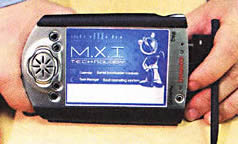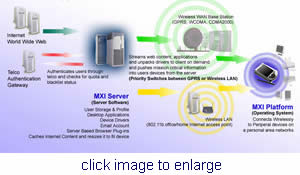 |
|
|
|
New mobile software runs Palm, Windows & Linux applications.
MXI is an operating system that utilizes a thin-client computing solution. Actually, server-centric computing may be a more precise expression to describe this kind of architecture. The idea behind thin-client computing is simple: centralize computing power, storage, applications, and data on "servers" (powerful computers) and provide users with an inexpensive "client" device (PDA) running the software capable of accessing the powerful software on the server.
The MXI client (a PDA for example, but it could also be a cellphone) connects to the server through a wireless connection to process applications, access files, print, and perform services available to ordinary computers. The advantages are many: lower technology costs, reliable computing, easy-to-use devices, low maintenance needs, and secure data. And, in the case of MXI, the ability to run any software anywhere. Being format neutral, the MXI platform allows communication between applications. This enables the ability to “drag & drop” contents between different vendors applications such as Palm, Microsoft, Linux, Java, etc. In fact, Intramedia recently demonstrated an iPaq running desktop versions of Word, PowerPoint and Internet Explorer. The same iPaq was also running a Pac-Man game for the Atari OS and a Linux version of StarOffice. A MXI powered PDA is capable of performing interim functions (calculations, editing) on the device, however when you want to save the changes/information the PDA connects to the server and saves your work on the server. This system of establishing a connection on demand reduces MXI’s bandwidth requirements, so a 28.8 Kbps modem could be used, Chandrasekar said. This means that a handheld with a GPRS or other 2.5G connection can run MXI, while handhelds on faster 3G, 802.11x or Bluetooth networks will enjoy even better responsiveness, he added. Benefits for Healthcare
|
||||||||


